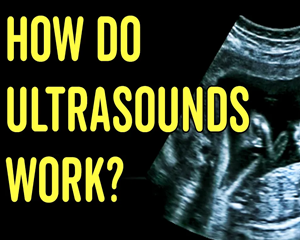In a pitch-black cave, bats can't see much. But even with their eyes shut, they can navigate rocky topography at incredible speeds.
在一片漆黑的洞穴里,蝙蝠看不到太多东西。但即便闭上眼,蝙蝠依然能以惊人的速度穿越岩石地形。
This is because a bat's flight isn't just guided by its eyes, but rather, by its ears.
这是因为蝙蝠不单是用眼睛去看路,而是用耳朵。
It may seem impossible to see with sound, but bats, naval officers, and doctors do it all the time, using the unique properties of ultrasound.
虽然用声音去看东西似乎不太可能,但蝙蝠、海军军官和医生经常这样做,他们借助了超声波的特性。
All sound is created when molecules in the air, water, or any other medium vibrate in a pulsing wave.
分子在空气、水或者是其他介质中以脉冲波的形式振动,进而产生声音。
The distance between each peak determines the wave's frequency, measured as cycles per second, or hertz.
波峰间的距离决定了波的频率,用每秒完成周期的次数赫兹来衡量。
This means that over the same amount of time, a high frequency wave will complete more cycles than a low frequency one.
也就是说,在相同的时间里,高频率的波比低频率波会完成更多的周期。
This is especially true of ultrasound, which includes any sound wave exceeding 20,000 cycles per second.
尤其是超声波,它包含了所有每秒完成2万次以上周期的声波。
Humans can't hear or produce sounds with such high frequencies, but our flying friend can.
人类听不到也无法发出如此高频的声音,但我们的蝙蝠朋友就可以做到。
When it's too dark to see, he emits an ultrasound wave with tall peaks.
当环境太暗看不清时,它会发出高峰值的超声波。
Since the wave cycles are happening so quickly, wave after wave rapidly bounces off nearby surfaces.
因为这种波的周期特别短,波会从附近的表面快速地反射回来。
Each wave's tall peak hits every nook and cranny, producing an echo that carries a lot of information.
波的高峰遍布洞穴里的每一个角落,产生携带大量信息的回声。
By sensing the nuances in this chain of echoes, our bat can create an internal map of its environment.
通过感受一系列回声的细微差别,蝙蝠就可以画出洞穴内部环境的地图。
This is how bats use sound to see, and the process inspired humans to try and do the same.
这就是蝙蝠用声音看东西的原理,这个过程启发了人类去尝试做同样的事。
In World War One, French scientists sent ultrasound beams into the ocean to detect nearby enemy submarines.
在第一次世界大战中,法国科学家向海洋发射超声波来探测敌方附近的潜水艇。
This early form of SONAR was a huge success, in large part because sound waves travel even faster through mediums with more tightly packed molecules, like water.
这个声呐雏形取得了巨大的成功,很大程度上是因为一些介质有更多紧密联系的分子,比如说水,声波在这样的介质里传播地更快。

In the 1950s, medical professionals began to experiment with this technique as a non-invasive way to see inside a patient's body.
在20世纪50年代,医学专业人员开始用这项技术做实验以非侵入的方式检查病人身体的内部。
Today, ultrasound imaging is used to evaluate organ damage, measure tissue thickness, and detect gallbladder stones, tumors, and blood clots.
今天超声成像被用来评估器官损伤的情况,测量组织厚度,探测胆囊结石,肿瘤和血栓。
But to explore how this tool works in practice, let's consider its most well-known use -- the fetal ultrasound. First, the skin is covered with conductive gel.
但要想弄明白如何在实践中应用这项技术的话,让我们来看一种最出名的用途--胎儿超声。首先,皮肤由导电凝胶所覆盖。
Since sound waves lose speed and clarity when traveling through air, this gooey substance ensures an airtight seal between the body and the wand emitting ultrasound waves.
因为在穿过空气时声波会损失一些速度和清晰度,这种黏性物质确保身体和仪器棒之间发射超声波的位置是密封的。
Then the machine operator begins sending ultrasound beams into the body.
然后仪器操作员会把超声束发射到体内。
The waves pass through liquids like urine, blood, and amniotic fluid without creating any echoes.
波穿过像尿液,血液,羊水这样的液体,不产生任何回声。
But when a wave encounters a solid structure, it bounces back. This echo is rendered as a dot on the imaging screen.
但当碰到固体结构时,波会反弹回去。回声在成像屏幕上以点的形式呈现。
Objects like bones reflect the most waves, appearing as tightly packed dots forming bright white shapes.
像骨头这样的物质反射大部分的波,并以紧密点构成亮白形状。
Less dense objects appear in fainter shades of gray, slowly creating an image of the fetus's internal organs.
密度较小的物质会以较模糊灰色的形状出现,慢慢地显示出胎儿内部器官的图像。
To get a complete picture, waves need to reach different depths in the patient's body, bypassing some tissues while echoing off others.
如果你想得到完整的图像的话,波需要在病人身体里到达不同深度的地方,绕开某些组织并在其他部位反射。
Since longer, low frequency waves actually penetrate deeper than short, high frequency ones, multiple frequencies are often used together and composited into a life-like image.
因为长波,低频率波实际上比于短波,高频率波渗透地更深,操作员经常混用多种频率的波来合成逼真的图像。
The operator can then zoom in and focus on different areas. And since ultrasound machines send and receive cascades of waves in real time, the machine can even visualize movement.
这样操作员就可以放大并关注不同部位。因为超声仪器会实时发射并收到一系列的波,机器甚至可以把动作可视化。
The waves used for medical ultrasound range from 2 million to 10 million hertz -- over a hundred times higher than human ears can hear.
医用超声波的频率在2百万到1千万赫兹之间--在人耳能听到频率的100倍以上。
These incredibly high frequencies create detailed images that allow doctors to diagnose the smallest developmental deviations in the brain, heart, spine, and more.
这些非常高频的波合成了详细的图像,医生可以借此诊断脑部、心脏、脊柱还有其他部位最细微的发育性偏斜。
Even outside of pre-natal care, medical ultrasound has huge advantages over similar technologies.
即便在非产前检查的领域,医用超声波仍比同类技术更具优势。
Unlike radiation-based imaging or invasive surgical procedures, ultrasound has no known negative side effects when used properly.
不像辐射成像或侵入性手术,只要使用得当,超声就没有明显的副作用。
At very high levels, the heat caused by ultrasound waves can damage sensitive tissues, but technicians typically use the lowest levels possible.
具有很高能量的超声波产生的热量可以毁坏敏感组织,但是技师通常尽可能使用最低能量的超声波。
And since modern ultrasound machines can be small and portable, doctors can use them in the field -- allowing them to see clearly in any medical emergency.
因为现代超声仪器体积小且易于携带,医生可以在工作场景下使用它们,这让医生们在任何紧急情况下都可以看得一清二楚。













